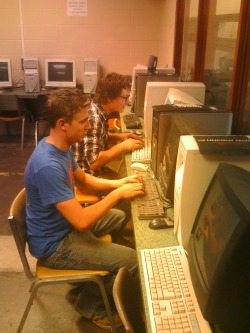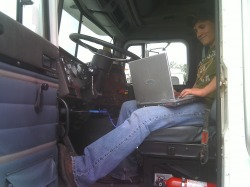Personal Technology Plan
The future is ever-changing. Something we take for granted now will someday be obsolete. We are a society that is always inventing improved ways of performing tasks with new technologies replacing older technologies. A perfect example is the trend of switching from land line phone to cell phones. According to a study by the CDC, the percentage of households with only a land line is currently at 15% while the percentage of cell phone-only homes has gone from 11% in 2006 to 25% today. We can only imagine what is store next and the advances will come quicker and quicker. We have barely begun to use Web 2.0 tools and soon Web 3.0 will be upon us. Students today must be prepared for changes, relying on fundamental knowledge to handle those changes.
I have learned through these courses that technology is a tool that when properly applied can enhance student performance. Choosing a proper technology to deliver instruction is like choosing the proper wrench for a given bolt. Before these classes, I had heard of many of the Web 2.0 tools, but they were simply a word or name. I did not even have a knowledge base to determine if they were tools I could use let alone how to actually implement them in my program. I now have a foundation on which to build. I still need to get more comfortable using the tools I have learned while exploring new technologies as they arise. I feel my biggest challenge is finding time to keep up with learning new applications when time is already pulled by family, classroom, academics and whatever happens to be the problem of the day.
As an educator, I want my students prepared for the future, not only with the hands-on abilities such as changing brakes or diagnosing a fuel problem, but also with the support systems that go along with a diesel technician’s profession. I teach a Diesel Technology program and previously, technology referred to technological advances in the industry, but computer-related technology has been thoroughly embedded in all aspects of this career field. Many of the students in my program are learning disabled or borderline LD with poor academic skills, but with a desire to learn the profession. Linking academics and technology to specific performance tasks creates an understanding within the student as to their value, a reason the student needs to have that knowledge. An example is that technicians must electronically document their diagnostics and repairs to accurately bill a customer, but also to be properly paid for work performed. If a repair is not documented, the technician doesn’t get paid.
A pitfall I do see in relying on technology is the inability to make reasonable and logical judgments based on a student’s own knowledge and the facts placed before them. Technology is a tool that can be used to help with judgments, but the user must be able to evaluate the findings and determine if they are reasonable. A trouble code only directs them to the defective system. They still have to diagnose the problematic part of the system. Many inexperienced technicians will simply scan a vehicle computer and recover a trouble code. They will automatically replace the part referenced by the trouble code and find they have not corrected the problem. That would be like replacing a printer when it won’t print without checking the power supply, cords or ink.
I have learned through these courses that technology is a tool that when properly applied can enhance student performance. Choosing a proper technology to deliver instruction is like choosing the proper wrench for a given bolt. Before these classes, I had heard of many of the Web 2.0 tools, but they were simply a word or name. I did not even have a knowledge base to determine if they were tools I could use let alone how to actually implement them in my program. I now have a foundation on which to build. I still need to get more comfortable using the tools I have learned while exploring new technologies as they arise. I feel my biggest challenge is finding time to keep up with learning new applications when time is already pulled by family, classroom, academics and whatever happens to be the problem of the day.
As an educator, I want my students prepared for the future, not only with the hands-on abilities such as changing brakes or diagnosing a fuel problem, but also with the support systems that go along with a diesel technician’s profession. I teach a Diesel Technology program and previously, technology referred to technological advances in the industry, but computer-related technology has been thoroughly embedded in all aspects of this career field. Many of the students in my program are learning disabled or borderline LD with poor academic skills, but with a desire to learn the profession. Linking academics and technology to specific performance tasks creates an understanding within the student as to their value, a reason the student needs to have that knowledge. An example is that technicians must electronically document their diagnostics and repairs to accurately bill a customer, but also to be properly paid for work performed. If a repair is not documented, the technician doesn’t get paid.
A pitfall I do see in relying on technology is the inability to make reasonable and logical judgments based on a student’s own knowledge and the facts placed before them. Technology is a tool that can be used to help with judgments, but the user must be able to evaluate the findings and determine if they are reasonable. A trouble code only directs them to the defective system. They still have to diagnose the problematic part of the system. Many inexperienced technicians will simply scan a vehicle computer and recover a trouble code. They will automatically replace the part referenced by the trouble code and find they have not corrected the problem. That would be like replacing a printer when it won’t print without checking the power supply, cords or ink.
I was one of the first non-computer related CTE programs in my building to create a computer lab within my lab area. I saw the need to have ready access to computers and the internet. As an industry, vehicle and equipment manufacturers have made the switch to a digital format. No longer do you use a repair manual in paper form or even in CD form. Almost all service, repair and parts information is in an online database. I use www.shopkey5.com for light-duty trucks. Students can look up a repair procedure, identify the correct parts with part numbers and prices and generate a repair bill including labor time.
I use several online training programs. These include: www.sp2.org covers safety and pollution prevention, www.virtualriskmanager.net/airbrakes is an air brake training program sponsored by Commercial Vehicle Safety Alliance and www.acdelcotechconnect.com has a parts look up, a technical magazine and an in-depth training program that is the same type of update training when employed by an OEM dealership. I encourage students to use forums such as www.thedieselstop.com, www.dieselplace.com and www.cumminsforum.com to answer performance problems beyond stock repairs. I must caution students that these are views or comments that may or may not be factual or complete. Students develop evaluation skills by comparing postings to what they already know. I will also use forum postings that ask for diagnostic help as troubleshooting scenarios in the classroom. After brainstorming possibilities, we critique the responses to the scenario for probability of a correct diagnosis. Students will then post a solution in response.
Technology plays a major role in developing employability skills. Students research career pathways and job descriptions using internet search engines while developing internet search skills. Microsoft Word is used to create resumes, cover letters and resignation letters. In order for students to make a career in any field, they have to get the job first. One of my technology goals is for ever student to have an electronic portfolio. Students can have access to their resumes, certification records and task lists at anytime to print documents and update information.
My plan for enhancing and increasing my use of technology includes the continued development of my Moodle LMS. My time-line for Moodle is to have the three beginning categories in place by the start of the 20110-11 school year. I plan to have a full implementation of Moodle for the 2011-12 school year. Throughout this next school year, I will work at developing the remaining categories by adding content to the categories as they are presented in instruction. I have ordered two Flip Video camcorders to use in recording lectures and procedures. I will be assigning students video projects to help accomplish these tasks. The pilot implementation was very successful. I will be transferring hand-out and worksheet documents to the Moodle site as they are presented in class with the idea to avoid being overwhelmed by trying to do it all at once. I will continue to expand my use of applications for the classroom setting. One application I will be using and learning over the summer is Windows Movie Maker. It is a common program on all of our school's computers and I will need to use it to edit videos. I plan to schedule one day every two months to explore a new application or program. I will also be working with administration to develop professional development programs centered upon new technologies.
I am further enhancing my program by adding eight more computers in my lab and I will also be adding a projector and document reader in the classroom area. I will be updating my instructor computer with a new laptop that has the capacity to handle more applications and give me mobility to use it where I need it. Next year, I would like to add at least 4 laptops on rolling carts for use on projects in the lab.
I want to use my program as an example for to other instructors, showcasing how technology can be used in their programs. Teachers have been introduced to Moodle but in such a way that they have been confused and unsure of the use of the application. Just like the students, the teachers need to see the benefits of a program before they will buy int it. There are so many demands on teacher's time that they have to value it before they even try it. I plan to be a teacher mentor to my colleagues, bringing them into the digital classroom.

